So I´ve got this Hifonics BXi 2000 D that is working now half-way.
Amp was already broken down, parts missing when i got it.
So i desoldered the output fet´s (not the same batch)
Power supply board was missing half of the vias on the underside of the board. So i just cut the pins and gave it a new "pinline" as I couldn´t desolder it.
I used IRF44Z and 47Ohm Gate-Resistors, old fets were already missing, Gate-Resistors slightly burned. Amp pulled 10A from my supply. Found out that the driver transistors on the board were mixed NPN/PNP side, drive signal was bad. Soldered in new driver transistors in the correct setup and got a clean Squarewave drive. So the supply side was fine so far.
Output board driver was bad, nice spark at the Output fet´s (IRFP250N). Desoldered the board and soldered in a new driver (IRS21844S)
Relais didn´t switch on, it switched before so i wasn´t sure what I destroyed now. Figured out that the Relais pin on the PS board just wasn´t making contact with the board.
Tested the board without load, it produced a clean sinewave with 50Hz to clipping. Then I tested it with 4,3Ohm and 1,6Ohm it worked to a certain point.
Gain in the middle position. With the 4,3Ohm it started hissing at 4,5V Input SineWave 50Hz.
44,8A from the Supply, 10,6A/44,5V at the output. The output signal get´s distored at that point.
With 1,6Ohm it starts hissing at 2,9V, 66,7A from the supply, 19,6A/27,3V at the output.
Both started making noises at a controlled point in 100mV steps. 4,4V were ok at 4,5 it started, the same with 1,6Ohm.
Then I tried it with a speaker, it just destroyed the speaker without even giving it a signal.
So my question is if someone experienced something similar?
Is the Output Drive still bad? I have 33mV DC at the output without a speaker.
I used a normal speaker, not a bass speaker if that makes a difference.
A bigger speaker didn´t die (I switched it off before it could reach that point?) but it build up noise, started oscillating? When I turned the amp off a higher tone was heard from the speaker. Much higher than I would expect from a bass amplifier.
Will make some pictures from the oscilloscope tomorrow when I can find my USB-Stick.
Thanks for reading and maybe an answer.
Will upload pictures later.
Amp was already broken down, parts missing when i got it.
So i desoldered the output fet´s (not the same batch)
Power supply board was missing half of the vias on the underside of the board. So i just cut the pins and gave it a new "pinline" as I couldn´t desolder it.
I used IRF44Z and 47Ohm Gate-Resistors, old fets were already missing, Gate-Resistors slightly burned. Amp pulled 10A from my supply. Found out that the driver transistors on the board were mixed NPN/PNP side, drive signal was bad. Soldered in new driver transistors in the correct setup and got a clean Squarewave drive. So the supply side was fine so far.
Output board driver was bad, nice spark at the Output fet´s (IRFP250N). Desoldered the board and soldered in a new driver (IRS21844S)
Relais didn´t switch on, it switched before so i wasn´t sure what I destroyed now. Figured out that the Relais pin on the PS board just wasn´t making contact with the board.
Tested the board without load, it produced a clean sinewave with 50Hz to clipping. Then I tested it with 4,3Ohm and 1,6Ohm it worked to a certain point.
Gain in the middle position. With the 4,3Ohm it started hissing at 4,5V Input SineWave 50Hz.
44,8A from the Supply, 10,6A/44,5V at the output. The output signal get´s distored at that point.
With 1,6Ohm it starts hissing at 2,9V, 66,7A from the supply, 19,6A/27,3V at the output.
Both started making noises at a controlled point in 100mV steps. 4,4V were ok at 4,5 it started, the same with 1,6Ohm.
Then I tried it with a speaker, it just destroyed the speaker without even giving it a signal.
So my question is if someone experienced something similar?
Is the Output Drive still bad? I have 33mV DC at the output without a speaker.
I used a normal speaker, not a bass speaker if that makes a difference.
A bigger speaker didn´t die (I switched it off before it could reach that point?) but it build up noise, started oscillating? When I turned the amp off a higher tone was heard from the speaker. Much higher than I would expect from a bass amplifier.
Will make some pictures from the oscilloscope tomorrow when I can find my USB-Stick.
Thanks for reading and maybe an answer.
Will upload pictures later.
Thanks for making this readable and informative.
Do you have a significant amount of the carrier wave getting to the speaker terminals?
Do you have a significant amount of the carrier wave getting to the speaker terminals?
I have a clear SineWave at the Output, 5V 5ms on the oscilloscope. Do I need to change the settings to see that waveform?
When I go over a certain Inputvoltage the Output gets distorted. Will post pictures of that tomorrow.
How do I measure the carrier wave? How does it look like. Does that mean that the Filter could be defective? I put new output filter caps in the amp. I hope you have some pictures of that case.
Thank you for the fast reply.
When I go over a certain Inputvoltage the Output gets distorted. Will post pictures of that tomorrow.
How do I measure the carrier wave? How does it look like. Does that mean that the Filter could be defective? I put new output filter caps in the amp. I hope you have some pictures of that case.
Thank you for the fast reply.
The carrier is the high-frequency rail-rail waveform found on the input of the output filter inductor.
When you increase the output, does that waveform get through the filter?
When you increase the output, does that waveform get through the filter?
The First Three pictures are the Signals at the power-supply fet's. GD, GS, DS.
The next Three are the low side output. Also GD, GS, DS.
The next Three are the high side output also GD, GS, DS.
The last Three pictures are the output without a load at 5,3V, 5,5V and 5,6V. Gain in middle Position 50Hz sine wave. Is it normal that it starts clipping so soon? Railvoltage is +/- 80V. Seems legit with the railcaps rated at 100V.
Will try to capture what happens when I use a speaker.
The next Three are the low side output. Also GD, GS, DS.
The next Three are the high side output also GD, GS, DS.
The last Three pictures are the output without a load at 5,3V, 5,5V and 5,6V. Gain in middle Position 50Hz sine wave. Is it normal that it starts clipping so soon? Railvoltage is +/- 80V. Seems legit with the railcaps rated at 100V.
Will try to capture what happens when I use a speaker.
Attachments
-
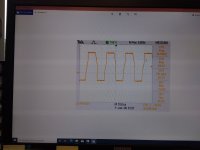 16524313000291100947926213615882.jpg301.7 KB · Views: 70
16524313000291100947926213615882.jpg301.7 KB · Views: 70 -
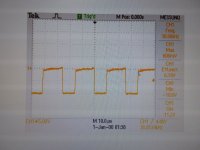 16524314093437760821289506517725.jpg590 KB · Views: 70
16524314093437760821289506517725.jpg590 KB · Views: 70 -
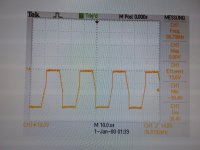 16524314313983036569271377154805.jpg784.6 KB · Views: 75
16524314313983036569271377154805.jpg784.6 KB · Views: 75 -
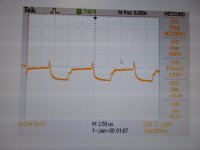 16524314900175342272140806049081.jpg293.4 KB · Views: 68
16524314900175342272140806049081.jpg293.4 KB · Views: 68 -
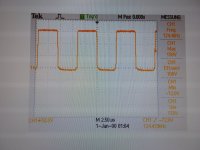 16524315075577642874485220807095.jpg672.6 KB · Views: 68
16524315075577642874485220807095.jpg672.6 KB · Views: 68 -
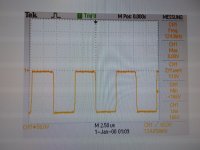 16524315388068453985614320264011.jpg687.4 KB · Views: 69
16524315388068453985614320264011.jpg687.4 KB · Views: 69 -
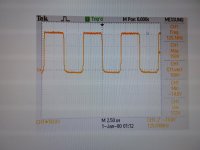 16524315620078808495880317157756.jpg600.1 KB · Views: 75
16524315620078808495880317157756.jpg600.1 KB · Views: 75 -
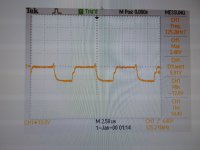 16524315865177116713765723125021.jpg662.6 KB · Views: 63
16524315865177116713765723125021.jpg662.6 KB · Views: 63 -
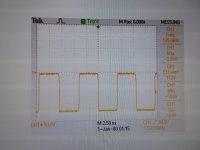 16524316095222011254771284628198.jpg485.6 KB · Views: 63
16524316095222011254771284628198.jpg485.6 KB · Views: 63 -
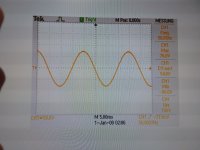 1652431866786760726034591684006.jpg730.8 KB · Views: 68
1652431866786760726034591684006.jpg730.8 KB · Views: 68 -
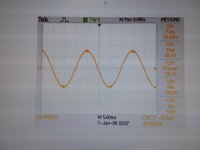 1652431908502760875180128675478.jpg579.4 KB · Views: 66
1652431908502760875180128675478.jpg579.4 KB · Views: 66 -
 16524319303101952271897657088977.jpg493.1 KB · Views: 74
16524319303101952271897657088977.jpg493.1 KB · Views: 74
I measured the carrier wave at the inductors. Right inductor are the 2 First pictures. The Other 3 are the left inductor. To be frank i've got no clue how it should Look.
I will search in the forum for a picture of the carrier wave at the inductors.
I will search in the forum for a picture of the carrier wave at the inductors.
Attachments
-
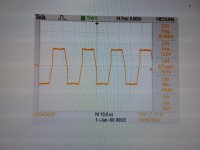 16524367245564561192274798469612.jpg730.7 KB · Views: 96
16524367245564561192274798469612.jpg730.7 KB · Views: 96 -
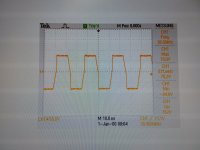 16524368164726593839577830800993.jpg680.6 KB · Views: 72
16524368164726593839577830800993.jpg680.6 KB · Views: 72 -
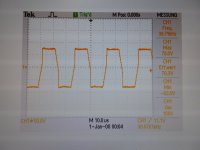 16524368372358099550240698276939.jpg274.6 KB · Views: 69
16524368372358099550240698276939.jpg274.6 KB · Views: 69 -
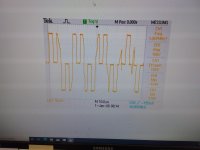 16524368513382096028558412786323.jpg419.4 KB · Views: 73
16524368513382096028558412786323.jpg419.4 KB · Views: 73 -
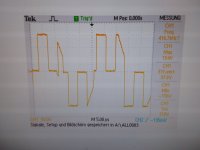 16524372104832821890255613324463.jpg274.9 KB · Views: 89
16524372104832821890255613324463.jpg274.9 KB · Views: 89 -
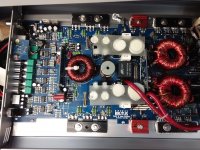 16524372328093077309624400942739.jpg598 KB · Views: 99
16524372328093077309624400942739.jpg598 KB · Views: 99
With a speaker at the output i can hear a very high humming/peep Sound that becomes gradually shriller and ends in a high "pop off" sound when I take the power away. On the speaker without any input a very high frequency gets injected.
Is that a sign for a defective filter?
Is that a sign for a defective filter?
Is the sound you're hearing, this:
http://www.bcae1.com/temp/cooleditmixedoscillator01.wav
The scope says that the signal is swinging ±75v. Are you using the correct probe/scope settings or is that signal actually only ±7.5v?
http://www.bcae1.com/temp/cooleditmixedoscillator01.wav
The scope says that the signal is swinging ±75v. Are you using the correct probe/scope settings or is that signal actually only ±7.5v?
Kinda that sound.
I measured directly at the inductorpins. Scope set to probe x10 and probe in x10 position too. Secondary ground to pins.
I measured directly at the inductorpins. Scope set to probe x10 and probe in x10 position too. Secondary ground to pins.
That sound is due to having un-synchronized oscillators for the PS And the audio stage carrier. There typically isn't anything you can do about it. It's not generally loud enough to be a problem.
Is that something that would be not noticeable with a bass-speaker? I used a normal speaker.
Does the rebuild of the PS with different parts make that problem stronger/ more apparent?
Why does that sound travel through the transformer, rectifier, the caps etc.?
What can one untypically do?
Does the rebuild of the PS with different parts make that problem stronger/ more apparent?
Why does that sound travel through the transformer, rectifier, the caps etc.?
What can one untypically do?
You would have to find a way to synchronize the two oscillators. That's above my pay-grade.
The amp wasn't designed to drive anything but subwoofers. Before deciding whether the problem is significant, ask yourself if the noise is going to be a problem with a subwoofer in the trunk of a vehicle.
No, different parts aren't likely to cause the problem.
The amp is doing, essentially, what the following oscillator does:
https://physicsmuseum.uq.edu.au/oscillator-beat-frequency
The amp wasn't designed to drive anything but subwoofers. Before deciding whether the problem is significant, ask yourself if the noise is going to be a problem with a subwoofer in the trunk of a vehicle.
No, different parts aren't likely to cause the problem.
The amp is doing, essentially, what the following oscillator does:
https://physicsmuseum.uq.edu.au/oscillator-beat-frequency
As I wrote a small 5W speaker got blown without an input signal. Does that sound normally have enough power to do that?
No.
What's the amplitude of the output signal that blew the speaker?
You shouldn't use fragile speakers to test amplifiers that are not known to be in 100% good working order. For subwoofer amplifiers, use a subwoofer that's rated (honestly) for about 250w RMS.
What's the amplitude of the output signal that blew the speaker?
You shouldn't use fragile speakers to test amplifiers that are not known to be in 100% good working order. For subwoofer amplifiers, use a subwoofer that's rated (honestly) for about 250w RMS.
Unsychronized oscillator beat notes can be a killer. As the Allstate commercial says, They create Mayhem in audio, video and medical images. Whenever possible and practical, EVERYONE! (as Gary Oldman said in The Professional), should be driven by or synched to one Master clock. The only thing worse is the moire patterns from striped and herringbone-weave clothes.That sound is due to having un-synchronized oscillators for the PS And the audio stage carrier. There typically isn't anything you can do about it. It's not generally loud enough to be a problem.
Is the term "Master" still allowed?
In car amplifiers, the noise is audible, especially in full-range speakers but it is at a sub-milliwatt level. It can't do any harm to speakers.
The term master/slave in electronics is standard.
I will work some more on the amp tomorrow.
Thanks for the help so far.
I will work some more on the amp tomorrow.
Thanks for the help so far.
Like your ears and mine - they're both logarithmic and Pulse Rate Modulation. Even with tinnitus, I can sometimes hear down to 18 dB above the A-weighted 1E-16 Watt per square cm reference level. I only worry about the speakers with DC or above a 120 dB SPL.In car amplifiers, the noise is audible, especially in full-range speakers but it is at a sub-milliwatt level. It can't do any harm to speakers.
Now, if you're in a high noise work or military environment, they have to screen you regularly for noise-induced hearing loss (NIHL). As you approach the lifetime (work only) limit of 9.1 Ergs per square cm (per my calculations), by law, you have to switch to a lower noise work environment. I'd prefer to live in an anechoic chamber, where nothing will bother me, except my own beating heart.
On midnight duty, I used to pull my fatigue cap over my eyes and sleep on top of the radar cabinets. Now, I have very sharp notches in both ears at 360 Hz, the Pulse Repetition Frequency of long range radar. They're so sharp, most audiologists miss them.
ron
- Home
- General Interest
- Car Audio
- Hifonics BXi 2000 D